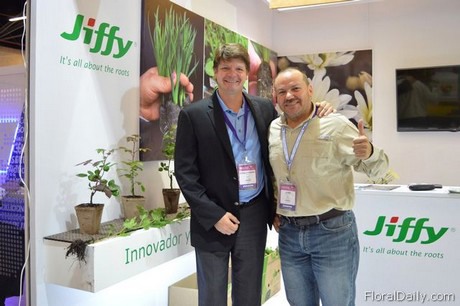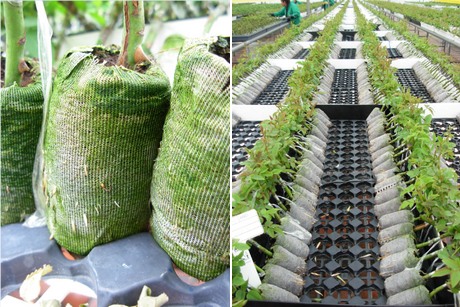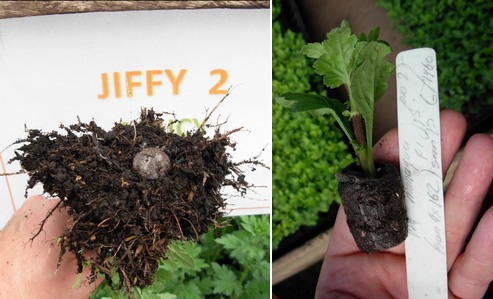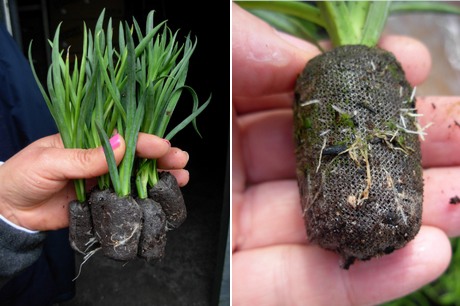
Don Willis of Jiffy and Javier Pacheco of Brinkman Trading, the distributor of Jiffy products in Central and South America were showing the pellet system at the Proflora in Bogota, Colombia.
The Jiffy pellet system
The Jiffy pellet system, also called J7 and J7C, is a rooting container and media in one product. The netting around the pellet is the container and allows for natural root development to occur laterally (horizontally). The netting also prevents over watering from occurring. "There are no walls to slow water drainage when gravitational pull occurs. So, water movement is natural, allowing for good porosity and O2 development in the Jiffy substrate. Besides that, the open pores of the netting allow the formed lateral root tips to naturally air prune, and develop increased lateral roots behind the air pruned tips. Thus, it increases the root growth capacity of the plant," explained Willis. According to him, this effect increases the root to soil surface area for increased nutrient and water uptake when the rooted plants are transplanted into the cut flower beds. "With the increased lateral rooting effect, cut flower production has the ability to occur one week faster in the cut flower beds. The Anastasia carnation variety only needs 14 weeks, instead of 15-16 weeks," says Willis.

Rose cuttings rooted in J7 Pellets.
Special heat treated sphagnum peat process
For rooting cut flower production, the J7 pellets use a special heat treated sphagnum peat process, According to Willis, this provides an optimum rooting environment due to elimination of pathogens. "When sticking cuttings from roses, carnations and chrysanthemums, with proper watering recommendations and proper temperature, rooting will occur in quicker time - we have seen similar results in taxus and eucalyptus production - by days to weeks depending on the variety," says Willis. "Another advantage, the rooted plants in a J7 can be transplanted as soon as you see root tips, and you do not have to wait for a root plug to form," added Willis

Chrysanthemum root growth from a J7.
Earlier rooting roses, carnations and chrysanthemums
Rose cuttings have rooted in as early as 21 days, carnations and chrysanthemums have rooted in 16 days. "These species will root in the Jiffy pellets very nicely using our regular horticulture net or our PLA biodegradable netting. The netting is folded around the substrate in the manufacturing process. So when the product arrives to the customer, the product can be used immediately for sticking after pellet expansion using hot water," says Willis. In the chrysanthemum and carnation cuttings, the J7 pellets have pre-made 3 mm diameter holes in the center of the pellet. According to Willis, this eliminates any stress to the stem at time of sticking, and enable workers to stick cuttings faster, improving the positioning/stability of the cutting.

Carnations rooted in J7.
Broad application
Next to roses, chrysanthemums and carnations, the Jiffy 7 pellets can be used for different species. "They are used globally by a variety of customers for not only sticking cuttings but also direct seeding," says Willis.
For more information

Jiffy
Don Willis
Email: [email protected]
www.jiffygroup.com
